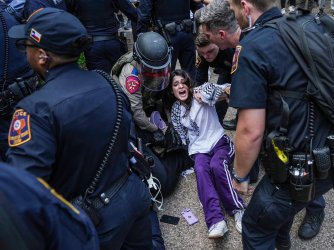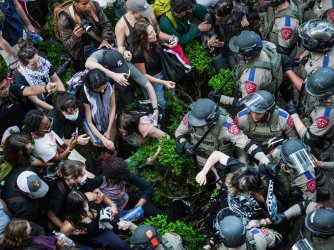Table of Contents
Responding to criticisms of the proposed Department of Education Title IX regulations

Table of Contents
Fairness of campus disciplinary proceedings
Defining prohibited harassment
The proper standard of evidence
Narrowing the scope of who is obligated to officially respond
Introduction
Since the Department of Education (ED) officially released its proposed Title IX regulations on November 16, there has been a flood of commentary analyzing the new regulations and what they will mean for how universities address sexual misconduct on campus.
One of the most significant things about the proposed regulations is the fact that they are, in fact, regulations. By law, this means the regulations will go through the public notice-and-comment process that the preceding guidance document — the April 4, 2011 “Dear Colleague” letter — did not. This notice-and-comment process will allow all interested parties to share their concerns with the government and the public. The feedback from all sides will, ideally, shape the precise language of the final regulations.
However, much of what has been written about the new regulations and the impact they will have on colleges’ ability to combat sexual misconduct on campus is simply inaccurate.
One of the pieces of commentary that has garnered the most attention is a statement by the American Civil Liberties Union criticizing the proposed regulations for their supposed lack of concern for the rights of victims of sexual harassment and assault.
Given that the ACLU is an organization that has historically been known for its defense of due process, free speech, and the rights of the accused in the criminal justice system, many readers would understandably assume that its statement on this issue would represent a thorough consideration of the the rights of all parties. Unfortunately, that is not the case. Given the widespread perception of the ACLU as an authority on issues of due process and free speech, and the important student and faculty interests affected by the proposed rulemaking, we felt it critical to address directly oversights in its statement and other well-publicized responses to the proposed regulations.
Fairness of campus disciplinary proceedings
The ACLU argues that “school disciplinary proceedings would not become fairer under the proposed rule.” But in terms of the sort of procedural protections for which civil libertarians generally advocate, school disciplinary proceedings would become markedly fairer under the proposed rule for both respondents and complainants.
Contrary to the ACLU’s contention that the proposed regulations simply “preserve” existing due process protections from OCR’s 2001 Revised Sexual Harassment Guidance, the draft regulations in fact introduce a number of specific procedural guarantees that a school would have to provide in order for its disciplinary process to comply with Title IX.
The 2001 Guidance states broadly that an equitable process must include an “[a]dequate, reliable, and impartial investigation of complaints, including the opportunity to present witnesses and other evidence.” While this should have been enough, the intervening years have demonstrated that such a general statement was inadequate to protect a student’s right to a fair process. The specific prescriptions in the new draft regulations directly address a number of procedural flaws commonly found in on-campus adjudications, and require schools to employ processes that are both more robust and more transparent in ways that will benefit all parties.
Critics quoted in an article in Inside Higher Ed express concerns about the proposed regulations’ recognition that students should have the right to see all the evidence in the case, subject witnesses to cross-examination, and even have live hearings at all, generally protesting that they would make college tribunals too much like real courts. Yet none of these protections are in any way unusual — rather, they’re basic elements of a fair procedure designed to deliver a just outcome, the types of fundamental procedural protections that one would rightly demand for oneself, a friend, or a family member accused of committing a heinous crime. If colleges are going to determine whether offenses (including crimes) occurred on their campuses, and do it fairly, the resulting process should require procedural protections calculated to assure a fair and defensible finding. Some of these protections are also used by courts, but that does not mean that incorporating some of them amounts to establishing formal jury trials.
- Hearings vs. the single investigator model
Take hearings, for example. Since the 2011 Dear Colleague letter, it has become increasingly common for schools to employ just one person to handle both the investigation and the adjudication of sexual misconduct complaints — the “single-investigator model.” The proposed regulations would bar this approach by requiring that the decision-maker “cannot be the same person(s) as the Title IX Coordinator or the investigator(s).”
The single-investigator model has proven deeply problematic in the years since its popularity began to grow. A number of the lawsuits by accused students alleging a lack of fundamental fairness in campus judicial proceedings turn on the problems inherent in that model. As one federal judge held in Doe v. Brandeis University (2016):
The dangers of combining in a single individual the power to investigate, prosecute, and convict, with little effective power of review, are obvious. No matter how well-intentioned, such a person may have preconceptions and biases, may make mistakes, and may reach premature conclusions.
By explicitly requiring the investigative and adjudicative functions to be performed by separate people, the proposed regulations increase fairness for both parties. After all, a school’s single investigator may have a bias that cuts either way, so separating these functions lessens the chance that any type of bias, whether in favor of complainants or respondents (or particular individuals) might infect the process.
- Access to all evidence, both inculpatory and exculpatory
Similarly, while the 2001 Guidance stated generally that both parties must be allowed to “offer evidence” in sexual misconduct proceedings, what has become clear in the intervening years is that universities frequently exclude much of that evidence without explanation, or refuse to share it with the parties — even when it might be of critical importance to the case.
In Doe v. Ohio State University (2016), for example, an accused student alleged that the complainant fabricated her story to avoid potential dismissal from OSU’s medical school for academic reasons. Although the complainant testified at the hearing that the university’s “decision to keep [her] in school and to allow [her] to continue next year in the fall was already decided before [her] decision to report this assault,” the university (but not the accused) had evidence to the contrary — but nonetheless did not contest the complainant’s statement at the hearing. The court ruled that the accused student’s right to cross-examination may have been “effectively denied by the Administrators’ failure to turn over critical impeachment evidence.”
The proposed regulations would require institutions to “[p]rovide both parties an equal opportunity to inspect and review any evidence obtained as part of the investigation that is directly related to the allegations raised in a formal complaint, including the evidence upon which the recipient does not intend to rely in reaching a determination regarding responsibility, so that each party can meaningfully respond to the evidence prior to conclusion of the investigation.”
This makes it more difficult for a university to withhold exculpatory evidence, as in Doe v. Ohio State, but it also makes it more difficult for a university to sweep an allegation of sexual misconduct under the rug by withholding inculpatory evidence as well. The provision guaranteeing both sides a robust right to see all of the evidence used in an investigation is one that advocates for both respondents’ and complainants’ rights should cheer.
- Cross-examination and the right to an advisor
The provision in the draft regulation allowing complainants and respondents to engage — through a third party such as an attorney or advisor — in cross-examination is another critical improvement that bolsters the fairness of campus sexual misconduct proceedings. The Supreme Court of the United States has called cross-examination “the greatest legal engine ever invented for the discovery of truth” when the credibility of witnesses is at stake. This is often the case in the campus sexual misconduct setting, where witnesses and physical evidence are frequently absent, leaving the outcome dependent upon the relative credibility of the two parties. And the fact that the cross-examination must be done through a party’s advisor — and that an advisor must be provided for this purpose if a party does not have one — means that accusers will not have to face direct questioning from the very person who allegedly harassed or assaulted them.
The proposed regulation follows the lead of the growing number of federal courts that have recognized cross-examination is essential to due process in the campus context. The U.S. Court of Appeals for the Sixth Circuit recently held in Doe v. Baum (2018), for example, that “if a public university has to choose between competing narratives to resolve a case, the university must give the accused student or his agent an opportunity to cross-examine the accuser and adverse witnesses in the presence of a neutral fact-finder.”
Defining prohibited harassment
One of the ACLU’s major claims is that under the proposed regulations “[s]chools would be required to investigate only the most extreme complaints of sexual violence.” The proposed regulations, it argues, “would dramatically limit the definition of sexual harassment that gives rise to investigations.” Neither of these claims are accurate.
As the ACLU notes, the definition of student-on-student sexual harassment articulated in the proposed rules is taken from the 1999 Supreme Court case Davis v. Monroe County Board of Education, the leading case in this area of the law. Both the Court in Davis and the rules proposed last week define such harassment as “[u]nwelcome conduct on the basis of sex that is so severe, pervasive, and objectively offensive that it effectively denies a person equal access to the recipient’s education program or activity.”
The Davis standard carefully balances schools’ obligation under Title IX to address sexual harassment and their obligation to protect students’ expressive rights. The Davis standard encompasses sexual violence, but it can also include repeated harassing conduct or even pure speech (without accompanying conduct) that interferes with a student’s access to education because of its severity and pervasiveness. While the Davis standard has its detractors — including the dissenting justices in the case, who thought the majority’s standard was too broad, not too narrow — the idea that only “extreme sexual violence” meets this standard is incorrect.
Instead, the ACLU would seem to prefer that peer sexual harassment be defined more broadly, as it has been in recent years. In 2013, the Departments of Education and Justice told institutions across the country to define sexual harassment as “any unwelcome conduct of a sexual nature,” including “verbal conduct.” The government’s promulgation of this breathtakingly broad definition of harassment led many universities to adopt an all but limitless definition of sexual harassment that infringes on students’ and faculty members’ right to free speech.
As FIRE and a broad coalition of free speech advocates explained in a 2013 letter to the Departments, that definition posed a significant threat to free speech and academic freedom. Even “a classroom discussion of Lolita, a campus reading of Allen Ginsberg’s ‘Howl,’ a dorm-room viewing of a Sarah Silverman comedy routine, or a cafeteria debate about same-sex marriage will each constitute ‘sexual harassment’ if a single student is made uncomfortable.”
Although the Departments subsequently walked back their statement that this definition should serve as a “blueprint” for institutions across the country, the damage was done: Many schools revised their definitions of sexual harassment to comply with the broader definition they believed was required by OCR, and many of those policies remain in effect to this day.
The rules’ reliance on the Davis standard isn’t a “depart[ure] from earlier Department guidance,” as the ACLU claims. Rather, it is wholly consistent with what ED said in its 2001 Revised Sexual Harassment Guidance, which did go through the notice and comment process. That guidance instructed schools that “the definition of hostile environment sexual harassment used by the Court in Davis is consistent with the definition” used by the Department.
Contrary to what many critics have argued, OCR even explicitly rejected the idea that a different standard for harassment should be used when a court determines liability in lawsuits against schools, as compared with when OCR determines a school has violated Title IX for its own enforcement purposes. ED wrote in its 2001 guidance: “[S]chools benefit from consistency and simplicity in understanding what is sexual harassment for which the school must take responsive action. A multiplicity of definitions would not serve this purpose.” So to the extent the proposed regulations feel like a “departure,” that is only because ED and the Department of Justice have, in recent years, insisted upon an unconstitutionally broad definition of sexual harassment unsupported by statutes, regulations, or case law. ED’s new proposed rules are a welcome return to the consistency established by the 2001 guidance.
The ACLU’s claim that the proposed regulations would “dramatically limit the definition of sexual harassment that gives rise to investigations” is also incorrect. Importantly, although schools will be limited in what expression they may lawfully punish, the scope of what they may — and, indeed, must — investigate, at least preliminarily, is much broader. The proposed rules state, quite explicitly, that a school “must investigate the allegations in a formal complaint.”
Schools must also, however, serve a gatekeeping function during the investigation process in order to ensure that students are not unduly burdened by a continuing investigation after it is established that their behavior, even if exactly as alleged, would not rise to the level of punishable harassment. The burden does not fall on students to conduct the legal analysis or limit themselves to reporting or complaining about only behavior that meets the Davis standard. Rather, it is the institution’s job to accept complaints and then make that determination.
The proper standard of evidence
Since the Office for Civil Rights issued its now-rescinded April 4, 2011 “Dear Colleague” letter, one of the most contentious debates has been over the appropriate standard of proof to use in campus sexual misconduct cases. Generally speaking, the standard of proof defines the degree of certainty that a fact-finder (for instance, a juror) must reach before finding against a party. The three standards at issue here are as follows:
- Beyond a reasonable doubt: Approximately 95-99% certainty. This is the standard used in all criminal trials in U.S. courts.
- Clear and convincing evidence: Approximately 75-85% certainty. This standard is frequently used in civil cases that involve allegations of fraud or some kind of quasi-criminal wrongdoing.
- Preponderance of the evidence: Approximately 50.01% certainty (anything over 50%, technically). Used in civil trials for money damages.
The ACLU argues the following:
The customary standard of proof for civil proceedings, where both sides have something to lose and there is no reason to favor one side over the other, requires proof by a preponderance of the evidence, which is more than 50 percent. The preponderance of the evidence standard applies in all other sexual harassment proceedings and should apply here as well.
This has long been the primary argument made by those who believe that Title IX should mandate that campus tribunals use the preponderance of the evidence standard — that of a mere 50.01% certainty — when determining whether or not a student committed any form of sexual misconduct, from verbal harassment to forcible rape. Since this is the standard in use for civil trials regarding these offenses (or, for those that are criminal offenses, their analogs in tort law), they say, it would be unfair to complainants to use any higher standard. After all, campus tribunals are not criminal courts, and their findings cannot result in jail time or criminal records.
But are campus proceedings that purport to determine whether or not a student sexually assaulted someone really best compared to a civil trial? Even under the proposed regulations, colleges will lack tools we deem critical in both civil and criminal litigation: the power to subpoena witnesses, the ability to take sworn testimony under penalty of perjury, rules that protect both parties from the introduction of unreliable or prejudicial evidence, and many more procedural requirements designed to achieve reliably just outcomes.
- Campus disciplinary proceedings are fundamentally different from civil lawsuits
Even this comparison, though, elides the most critical difference between civil litigation and college discipline, which is that their aims are fundamentally different. As Joe Cohn, FIRE’s legislative and policy director, wrote in The Chronicle of Higher Education all the way back in 2012:
One other important feature distinguishes civil lawsuits from campus proceedings: Civil suits can be settled for money and kept confidential. Yet students accused of sexual misconduct cannot simply settle the case for money and stay in school. Preponderance advocates should ask themselves why this is so. If the answer is that campus sexual misconduct is more like a crime (with a victim and alleged perpetrator) than a civil dispute (with a plaintiff and defendant)—as is certainly the case—then why is the preponderance standard sufficient for charges of sexual misconduct on campus?
FIRE knows of no college or university where accused students can “settle” a case by paying money to their accusers, and if we found one where that was the case, we, like everyone else, would be appalled by the injustice.
Campus proceedings attempt to determine if an offense that violates the school’s disciplinary code took place and what the consequences for the offending student should be. Their judgments come with all of the attending moral opprobrium. This is a fundamentally different goal from that of tort law. Simply put, in a campus court, just like in a criminal court, it’s not about the money.
- Use of the “clear and convincing evidence” standard
The intermediate “clear and convincing evidence” standard is appropriate for these types of disputes. As the Supreme Court explained in Addington v. Texas (1979), “One typical use of [this] standard is in civil cases involving allegations of fraud or some other quasi-criminal wrongdoing by the defendant. The interests at stake in those cases are deemed to be more substantial than mere loss of money … . Similarly, this Court has used the ‘clear, unequivocal and convincing’ standard of proof to protect particularly important individual interests in various civil cases.” Those found to have committed sexual misconduct by a campus tribunal not only suffer reputational damage but are also likely to be prevented from ever completing their education. That’s a consequence that no amount of money can correct, and warrants a little more certainty than 50.01%.
For a school to require clear and convincing evidence before declaring a student’s guilt in a sexual misconduct case would hardly be a radical step. (It is, in fact, the proper standard to apply to faculty, according to the American Association of University Professors.) Yet the new regulation does not even require that standard’s use; it merely restores it as an option. Even if the due process improvements being considered in the proposed regulations come to pass, students will still have far fewer protections than they would find in those civil trials using the preponderance of the evidence standard. So adopting a higher standard of proof is a step that we believe universities interested in justice should take.
A final note on this point: the ACLU accurately states that “[p]revious Department of Education guidance adopted” the preponderance standard. But that doesn’t mean that there was any law, regulation, or general understanding that preponderance was the best standard. The preponderance mandate appeared in the now-rescinded April 4, 2011 “Dear Colleague” letter, and took colleges by surprise. Up until April 2011, schools were using a variety of different standards, and had been doing so for decades, as neither the text of Title IX, nor regulations then in force, mandated the use of any specific standard. The requirement to use the preponderance standard is the historical aberration, not vice versa.
Narrowing the scope of who is obligated to officially respond
The ACLU also argues that “[u]niversities would only be obligated to respond to complaints of sexual violence made to designated high-level officials.” It laments: “If students reported their assaults to resident advisors, teaching assistants, coaches, or other school employees whom they know and trust, schools would not be obligated to intervene.”
But there are compelling reasons not to support rules that require the majority of school employees to report any information about alleged sexual misconduct to high-level officials. When a discussion of sexual misconduct is germane to a particular course, this type of mandatory reporting rule could significantly chill meaningful classroom conversations. Limiting mandatory reporting rules to administrators or select staff may allow these discussions to happen more freely, so that students may learn from each others’ experiences.
Professors have been arguing for several years that mandatory reporting rules also put them in an extremely difficult position, as they may be obligated to betray a student’s trust by sharing information that the student does not wish to share. Students may offer this information before a professor even has a chance to explain their obligation to report it.
Conclusion
Of course, this is not a comprehensive catalog of the commentary on the proposed regulations; more criticism (and praise) may be readily found online and elsewhere. FIRE will continue to address flawed characterizations of the regulations, point out potential areas for improvement, and highlight provisions that will help secure just outcomes for all.
On that note, we again note several aspects of the proposed regulations that have received insufficient attention from commentators — mandating an explicit presumption of innocence, for example, or ensuring that administrators involved in the judicial proceedings are free from conflicts of interest. There has also been relatively little coverage of the proposed rules’ repeated emphasis on supportive measures that can be provided to victims even when the misconduct alleged does not fall into the categories of behavior a school may punish under Title IX.
We remind critics and proponents alike that the proposed regulations will be subject to public comment for 60 days from the date it is published in the Federal Register. FIRE looks forward to the continuing debate about how to approach sexual misconduct on campus in a way that protects civil liberties and provides a fundamentally fair proceeding for all parties.
Recent Articles
FIRE’s award-winning Newsdesk covers the free speech news you need to stay informed.

Texas tramples First Amendment rights with police crackdown of pro-Palestinian protests

Here’s what students need to know about protesting on campus right now

Kansas takes a stand for intellectual freedom
